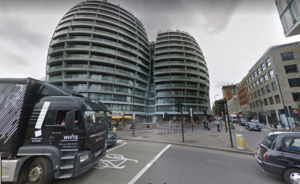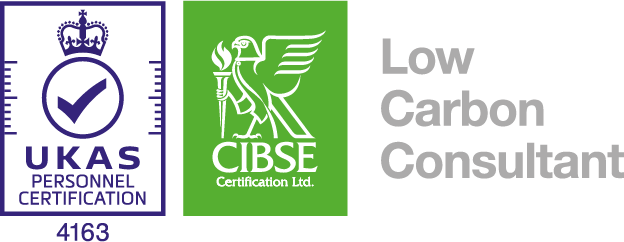Acoustics vs overheating risk – resolving the tension
Best practice members met on 17th January 2018 to discuss the conundrum of balancing the need to mitigate overheating risk in homes with the competing requirement to maintain a comfortable internal acoustic environment. Bluntly – opening windows to cool an apartment risks increasing the external noise audible inside to unsatisfactory levels. Poor external air quality will also have a greater impact on the internal environment when windows are opened.

Image from google street view
These concerns peak in urban environments where dwellings are more likely to be built near to busy roads, railways etc.
CIBSE TM59 was published in 2017 and provides a methodology for assessing overheating risk in new homes at the design stage. The methodology is based on an adaptive thermal comfort approach which assumes that occupants will open windows when they get too warm. The control of being able to do this and the consequent breeze improves thermal comfort in warm weather.
Since TM59 was published there have been many questions raised about how this approach links with sites where there are acoustic (or air quality) concerns which compromise the benefits of opening windows.
We invited Anthony Chilton (@AnthonyChilton) from Max Fordham to the meeting to pick his brains. Anthony is a member of the ANC (Acoustics and Noise Consultants) group who are working to produce a guidance document: AVOG – Acoustics, Ventilation and Overheating Guidance which is due out for consultation very soon.
This document is intended to:
- Help acousticians understand ventilation and overheating
- Set out desirable indoor ambient noise levels
- Provide quantitative, usable guidance – for designers, planners, testing
- Give worked examples/case-studies
The intention is that the document will encourage acousticians to provide calculated noise levels not just with windows closed, but also with them open for each occupied room. Depending on where these predictions fall in the table below would determine the relative risk level.
Units where the windows-open noise levels are predicted to be in the low category need not be concerned about windows opening.
Units where internal levels fall into the medium or high categories will need some further consideration. One key question is how much of the year the windows would need to be open for in order to mitigate the overheating risk. If this is a few hours for a few weeks then this may be acceptable, if it is for 6 months of the year then it is less likely to be ok.
It is important to note that there are different values for day and night noise levels. Disturbed sleep is known to have significant long-term health implications hence the tighter requirements at night.
The TM59 steering committee are engaging with this and looking in to requiring a count of the number of day and night-time hours that models are predicting windows will open for as part of overheating mitigation.
Either some consensus might be found as to what constitutes acceptable day and night window-open periods for both medium and high risk noise environments; or it could be left to developers to define their attitude to this risk, and decide if the open hours predicted are acceptable. Either approach would be more informed than a blanket assumption that all windows will be kept closed after a certain noise threshold.
The ANC are also keen to raise awareness of passive design measures that can reduce the ingress of external noise. These include
- Materials with acoustic absorption properties used on the underside of balconies
- Solid balustrades to balconies rather than railings
- Acoustic vents (NB there are questions as to whether these still satisfy the adaptive approach given the reduction in breeze that they allow)
- Green infrastructure – trees, planting including living walls can all help dampen noise levels. Typically a brick surface will only absorb 2% of the sound wave energy, whereas a green wall can absorb around 70%. See Max Fordham Greening Cities: http://www.maxfordham.com/research-innovation/greening-cities-2/
- Some window opening types are thought to allow less noise transmission https://www.linkedin.com/pulse/look-facade-window-design-quiet-low-carbon-buildings-noisy-ze-nunes/
The above has all referred to the ingress of external noise. Another consideration is noise generated internally by HVAC equipment. MVHR and MEV systems designed to provide background (Part F) ventilation fall within the free-running category for TM59, but must meet the Guide A acoustic criteria as shown below:
This becomes much harder if the mechanical plant is asked to provide higher ventilation rates to compensate for reduced opening windows.
There is an important distinction between ‘boost’ modes used for purging paint fumes, burnt toast, farts etc, and the longer term higher ventilation rates needed to mitigate overheating. For the former, higher noise levels are usually acceptable, for the latter much less so, as people will need to be able to live and sleep with them running for much longer periods.
This debate needs more work and research, but with the collaboration of acousticians and thermal modellers there is hope that a sensible recommendation can be made.
 Posted by Susie Diamond
Posted by Susie Diamond- Posted in Overheating, Research
 Jan, 26, 2018
Jan, 26, 2018 Comments Off on Acoustics vs overheating risk – resolving the tension
Comments Off on Acoustics vs overheating risk – resolving the tension

 Susie: 07972 263 676
Susie: 07972 263 676

 Join Us On In.com
Join Us On In.com

